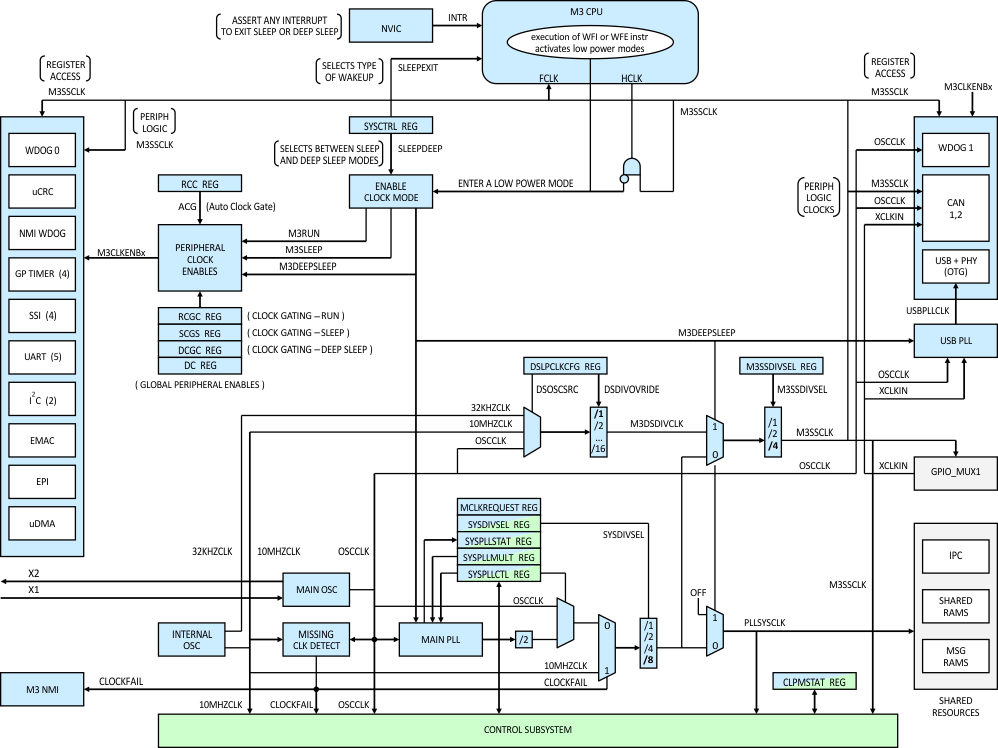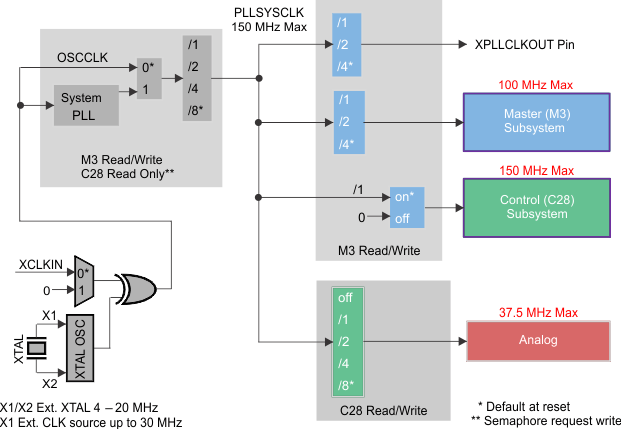SPRS825F October 2012 – June 2020 F28M36H33B2 , F28M36H53B2 , F28M36P53C2 , F28M36P63C2
PRODUCTION DATA.
- 1Device Overview
- 2Revision History
- 3Device Comparison
- 4Terminal Configuration and Functions
-
5Specifications
- 5.1 Absolute Maximum Ratings
- 5.2 ESD Ratings – Commercial
- 5.3 Recommended Operating Conditions
- 5.4 Power Consumption Summary
- 5.5 Electrical Characteristics
- 5.6 Thermal Resistance Characteristics for ZWT Package (Revision 0 Silicon)
- 5.7 Thermal Resistance Characteristics for ZWT Package (Revision A Silicon)
- 5.8 Thermal Design Considerations
- 5.9
Timing and Switching Characteristics
- 5.9.1 Power Sequencing
- 5.9.2
Clock Specifications
- 5.9.2.1 Changing the Frequency of the Main PLL
- 5.9.2.2
Input Clock Frequency and Timing Requirements, PLL Lock Times
- Table 5-5 Input Clock Frequency
- Table 5-7 Crystal Oscillator Electrical Characteristics
- Table 5-8 X1 Timing Requirements - PLL Enabled
- Table 5-9 X1 Timing Requirements - PLL Disabled
- Table 5-10 XCLKIN Timing Requirements - PLL Enabled
- Table 5-11 XCLKIN Timing Requirements - PLL Disabled
- Table 5-12 PLL Lock Times
- 5.9.2.3 Output Clock Frequency and Switching Characteristics
- 5.9.2.4 Internal Clock Frequencies
- 5.9.3 Timing Parameter Symbology
- 5.9.4 Flash Timing – Master Subsystem
- 5.9.5 Flash Timing – Control Subsystem
- 5.9.6 GPIO Electrical Data and Timing
- 5.9.7 External Interrupt Electrical Data and Timing
- 5.10
Analog and Shared Peripherals
- 5.10.1 Analog-to-Digital Converter
- 5.10.2 Comparator + DAC Units
- 5.10.3 Interprocessor Communications
- 5.10.4
External Peripheral Interface
- 5.10.4.1 EPI General-Purpose Mode
- 5.10.4.2 EPI SDRAM Mode
- 5.10.4.3 EPI Host Bus Mode
- 5.10.4.4
EPI Electrical Data and Timing
- Table 5-52 EPI SDRAM Interface Switching Characteristics (see , , and )
- Table 5-53 EPI Host-Bus 8 and Host-Bus 16 Interface Switching Characteristics (see , , , and )
- Table 5-54 EPI Host-Bus 8 and Host-Bus 16 Interface Timing Requirements (see and )
- Table 5-55 EPI General-Purpose Interface Switching Characteristics (see )
- Table 5-56 EPI General-Purpose Interface Timing Requirements (see and )
- 5.11
Master Subsystem Peripherals
- 5.11.1 Synchronous Serial Interface
- 5.11.2 Universal Asynchronous Receiver/Transmitter
- 5.11.3 Cortex-M3 Inter-Integrated Circuit
- 5.11.4 Cortex-M3 Controller Area Network
- 5.11.5 Cortex-M3 Universal Serial Bus Controller
- 5.11.6 Cortex-M3 Ethernet Media Access Controller
- 5.12
Control Subsystem Peripherals
- 5.12.1 High-Resolution PWM and Enhanced PWM Modules
- 5.12.2 Enhanced Capture Module
- 5.12.3 Enhanced Quadrature Encoder Pulse Module
- 5.12.4 C28x Inter-Integrated Circuit Module
- 5.12.5 C28x Serial Communications Interface
- 5.12.6 C28x Serial Peripheral Interface
- 5.12.7
C28x Multichannel Buffered Serial Port
- 5.12.7.1
McBSP Electrical Data and Timing
- 5.12.7.1.1 McBSP Transmit and Receive Timing
- 5.12.7.1.2
McBSP as SPI Master or Slave Timing
- Table 5-81 McBSP as SPI Master or Slave Timing Requirements (CLKSTP = 10b, CLKXP = 0)
- Table 5-82 McBSP as SPI Master or Slave Switching Characteristics (CLKSTP = 10b, CLKXP = 0)
- Table 5-83 McBSP as SPI Master or Slave Timing Requirements (CLKSTP = 11b, CLKXP = 0)
- Table 5-84 McBSP as SPI Master or Slave Switching Characteristics (CLKSTP = 11b, CLKXP = 0)
- Table 5-85 McBSP as SPI Master or Slave Timing Requirements (CLKSTP = 10b, CLKXP = 1)
- Table 5-86 McBSP as SPI Master or Slave Switching Characteristics (CLKSTP = 10b, CLKXP = 1)
- Table 5-87 McBSP as SPI Master or Slave Timing Requirements (CLKSTP = 11b, CLKXP = 1)
- Table 5-88 McBSP as SPI Master or Slave Switching Characteristics (CLKSTP = 11b, CLKXP = 1)
- 5.12.7.1
McBSP Electrical Data and Timing
-
6Detailed Description
- 6.1 Memory Maps
- 6.2 Identification
- 6.3 Master Subsystem
- 6.4 Control Subsystem
- 6.5 Analog Subsystem
- 6.6 Master Subsystem NMIs
- 6.7 Control Subsystem NMIs
- 6.8 Resets
- 6.9 Internal Voltage Regulation and Power-On-Reset Functionality
- 6.10 Input Clocks and PLLs
- 6.11 Master Subsystem Clocking
- 6.12 Control Subsystem Clocking
- 6.13 Analog Subsystem Clocking
- 6.14 Shared Resources Clocking
- 6.15 Loss of Input Clock (NMI Watchdog Function)
- 6.16 GPIOs and Other Pins
- 6.17 Emulation/JTAG
- 6.18 Code Security Module
- 6.19 µCRC Module
- 7Applications, Implementation, and Layout
- 8Device and Documentation Support
- 9Mechanical, Packaging, and Orderable Information
6.11 Master Subsystem Clocking
The internal PLLSYSCLK clock, normally used as a source for all Master Subsystem clocks, is a divided-down output of the Main PLL or X1 external clock input, as defined by the SPLLCKEN bit of the SYSPLLCTL register.
There is also a second oscillator that internally generates two clocks: 32KHZCLK and 10MHZCLK. The 10MHZCLK is used by the Missing Clock Circuit to detect a possible absence of an external clock source to the Main Oscillator that drives the Main PLL. Detection of a missing clock results in a substitution of the 10MHZCLK for the PLLSYSCLK. The CLKFAIL signal is also sent to the NMI Block and the Control Subsystem where this signal can trip the ePWM peripherals.
The 32KHZCLK and 10MMHZCLK clocks are also used by the Cortex-M3 Subsystem as possible sources for the Deep Sleep Clock.
There are four registers associated with the Main PLL: SYSPLLCTL, SYSPLLMULT, SYSPLLSTAT and SYSDIVSEL. Typically, the Cortex-M3 processor writes to these registers, while the C28x processor has read access. The C28x can request write access to the above registers through the CLKREQEST register. Cortex-M3 can regain write ownership of these registers through the MCLKREQUEST register.
The Master Subsystem operates in one of three modes: Run Mode, Sleep Mode, or Deep Sleep Mode. Table 6-25 shows the Master Subsystem low-power modes and their effect on both CPUs, clocks, and peripherals. Figure 6-10 shows the Cortex-M3 clocks and the Master Subsystem low-power modes.
Table 6-25 Master Subsystem Low-Power Modes
| Cortex-M3
LOW-POWER MODE |
STATE OF
Cortex-M3 CPU |
CLOCK TO
Cortex-M3 PERIPHERALS |
REGISTER USED TO GATE CLOCKS TO Cortex-M3 PERIPHERALS | MAIN PLL | USB PLL | CLOCK TO C28x | CLOCK TO SHARED RESOURCES | CLOCK TO ANALOG SUBSYSTEM |
|---|---|---|---|---|---|---|---|---|
| Run | Active | M3SSCLK(1) | RCGC | On | On | PLLSYSCLK(2) | PLLSYSCLK(2) | ASYSCLK(3) |
| Sleep | Stopped | M3SSCLK(1) | RCGC or SCGC(4) | On | On | PLLSYSCLK(2) | PLLSYSCLK(2) | ASYSCLK(3) |
| Deep Sleep | Stopped | M3DSDIVCLK(5) | RCGC or DCGC(4) | Off | Off | Off | Off | Off |
Figure 6-11 shows the system clock/PLL.
 Figure 6-10 Cortex-M3 Clocks and Low-Power Modes
Figure 6-10 Cortex-M3 Clocks and Low-Power Modes  Figure 6-11 System Clock/PLL
Figure 6-11 System Clock/PLL